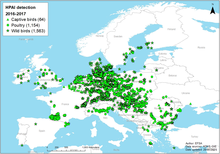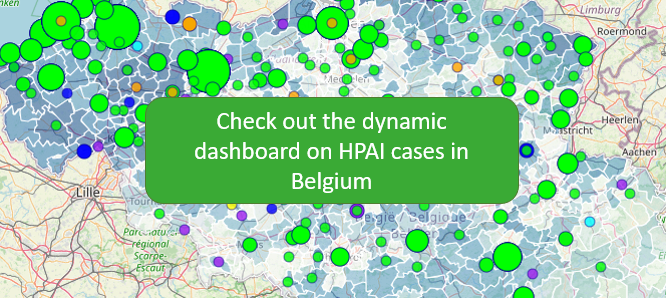Interactive map of cases of highly pathogenic avian influenza H5N1/H5Nx in Belgium from 01/10/2021 onwards.
Cases of highly pathogenic avian influenza H5N1/H5Nx in Belgium from 01/10/2023 onwards.
Updated on 16/04/2024.

The map above shows all detections of the highly pathogenic H5N1 avian influenza virus in Belgium from October 1, 2023. In it are:
- wild birds: circles
- domestic breeding: triangles
- mammals: square
Bird flu in Belgium season 2023-2024
During the 2022-2023 bird flu season, 13 professional keepers, 19 hobby keepers, 250 wild birds, 18 wild mammals, and 1 animal park in Belgium were diagnosed with H5 highly pathogenic avian influenza (HPAI). These figures indicate a high infection pressure in wildlife and thus risky conditions for the industry.
Also, just like last year, a number of wild birds tested positive in Belgium and Europe during the summer, confirming that the virus currently circulating is no longer seasonal but nesting in the wild bird population. However, the number of positive cases on a weekly basis declined from August 2023 before falling back to zero at the start of the 2023-2024 season. No new cases were identified in October and November 2023, which was markedly different from the start of the previous season (2022-2023), which did experience a new wave of infection in the autumn months.
On 1 December 2023, a first outbreak of HPAI-H5N1 in a professional poultry farm was confirmed by Sciensano’s National Reference Laboratory (NRL). This reintroduction confirms the ongoing risk and underlines the need to maintain a very high level of vigilance and biosecurity in the Belgian poultry industry.
Following a second detection of the virus in the sector, a nationwide compulsory caging of professional poultry was also reintroduced by the relevant minister. Then, on 11 December, the first wild bird of the season, a curlew (Numenius arquata), tested positive for High Pathogenic avian influenza. The NRL is working with regional (Flanders ANB, Wallonia SPW and Brussels LB) and federal (FASFC) authorities to collect sick and dead birds for investigation to continuously monitor the situation in the field.
Sciensano’s NRL avian influenza carries out further characterisations of these viruses. This includes isolating the virus, determining its complete genome and setting up pathogenicity studies. Thus, the NRL evaluates the evolution of the virus and the risks to birds and the level of adaptation to mammals.
For the first poultry outbreak, the virus was shown to be of a very recent new genotype “DG”, clustering with 2 other strains isolated from poultry in Germany (November). This genotype has the same composition as the “AB” genotype except for the PB2 and PA gene segments. The “AB” genotype has been detected most frequently in our neighbouring European countries since the start of the new season.
The European Centre for Disease Prevention and Control (ECDC) rates the risk of transmission to humans as low for the general European population.
The risk for occupationally exposed groups, such as veterinarians, is rated as low to medium.When handling sick or dead birds, wearing protective equipment such as gloves and a face mask is therefore recommended. If you should exhibit flu-like symptoms after contact with sick or dead birds, it is best to turn to your GP, mentioning this contact.
Previous seasons and outbreaks
Bird Flu in Belgium
Only two outbreaks of HPH5Nx were observed in 2020 whereas, in 2021, the Belgian NRL for Avian Influenza confirmed 11 outbreaks on farms (6) and in animals living in captivity, and all of this without any real interruption over the summer period. A remarkable development because, up to then, the outbreaks of the influenza virus occurred primarily in the winter period and there was a characteristic “summer break”. The loss of seasonality could indicate persistent circulation of the virus in animals living in the wild.
The autumn migration of wild birds in 2021 breathed new life into the epidemic, bringing with it a stream of new highly pathogenic H5Nx-viruses. The first positive wild bird of the new wave in Belgium was confirmed on 12 November 2021, and was followed by the first positive poultry business on 8 December 2021. The 2021-2022 bird-flu season was testament to the usefulness of the surveillance of wild birds as a warning system.
In 2021, 30 wild birds, such as geese, ducks, birds of prey and coastal birds, tested positive for the highly-pathogenic H5Nx-strain of the virus. Within one month (January 2022), there were an additional 30 new detections in wild birds, meaning there was a lot of (highly-pathogenic H5) bird-flu virus circulating among these animals (high infection levels) at the time. These cases in wild birds were primarily detected in the north of our country, which is particularly densely populated with water birds, but which is also where the vast majority of our poultry businesses are located. The first wild bird to test positive in Wallonia was reported on 9 February 2021 in the province of Liège.
During the 2021-2022 season, the cases identified in wildlife increased sharply, and 7 outbreaks were notified in the domestic poultry farming sector (6 professional farms and one private farm).
Bird flu in Europe
Since 2014, the highly pathogenic form of the bird flu virus (highly pathogenic H5Nx-influenza strains) has occurred regularly in Europe. Since 2016, this has been the “clade 2.3.4.4b H5” strain.
|
Season |
Number of outbreaks in Europe |
|---|---|
|
2016-2017 |
2,781 |
|
2017-2018 |
166 |
|
2018-2019 |
21 |
|
2019-2020 |
334 |
|
2020-2021 |
3,559 |
| 2016-2017 | 2017-2018 |
 |
 |
| 2018-2019 | 2019-2020 |
 |
 |
| 2020-2021 | |
 |
Figure 1: Representation of the outbreaks in the various clade 2.3.4.4b HPAI-H5 seasons since 2016 (source: EFSA). Circle = outbreak in poultry, star = outbreak in wild birds, triangle = outbreak in birds living in captivity.
The type of virus currently circulating is especially virulent for both poultry and birds living in the wild. The European Food Safety Authority (EFSA) has labeled the bird flu outbreak of the winter of 2020-2021 the most devastating and long-lasting epidemic of highly pathogenic avian influenza (HPAI) that has ever occurred in Europe.
More info on the webpage of the NRL Avian Influenza



